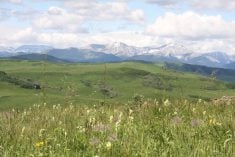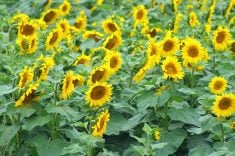Top-dressing established grass forage and winter cereals with nitrogen fertilizer is an established practice on the Prairies, but it can also be an economically sound management alternative for cereal and canola crops.
For those who are considering this practice for the first time, there are several key issues to consider. Top-dressing nitrogen fertilizer is commonly considered when post-seeding rainfall increases a crop’s yield potential and additional nitrogen is required to reach a higher yield.
Top-dressing is also considered when on-farm economics dictate a reduction of fall or spring applied nitrogen. If winter snowfall and spring rain improve a crop’s yield potential, a top-dressed nitrogen application can be made.
Read Also

Gene editing digs deeper space in Canadian plant breeding
More Canadian research into crop variety development is incorporating gene editing, and one researcher notes that Canada’s regulatory approach to gene editing will help drive innovation
Top-dressing nitrogen can also be used to increase grain protein content. This should be considered only when the added value of the protein increase offsets additional top-dressing costs.
In each of these situations, the return from your land is increased, provided that the value of the potentially higher profit offsets the cost of the extra field operation.
Top-dressed nitrogen can be as effective as pre-emergent nitrogen. The accompanying table shows the importance of applying nitrogen before or at seeding. It compares the effect of two treatments in which all nitrogen was applied after seeding. It also indicates that post-emergent applications can be an effective means of nitrogen application.
It is important to remember that the efficiency of top-dressed nitrogen will depend on rainfall to move the nitrogen into the rooting zone. Rainfall is not necessarily required after foliar nitrogen application because with a foliar nitrogen application a percentage of the nitrogen is absorbed by the leaf. However, nitrogen that doesn’t strike the leaf surface will land on the soil and rainfall will be required to move it into the plants’ rooting zone.
The greatest yield benefit for top-dressed nitrogen occurs when applications are made at or before cereal’s three-leaf to five-leaf stage. In canola, application should be made before or when the plants are in the rosette stage with four true leaves. This is because the crop’s yield potential is determined during these developmental stages.
Because the crop determines its yield potential early, it is important to have the required nutrients available to the crop at this time. Applying nitrogen later than the yield-determining stage will result in the nitrogen being used to increase protein content more than grain yield.
Top-dressed nitrogen left on the soil or plant surface is susceptible to volatile loss or gassing off. The extent of these losses depends on climate, soil type and condition, and type of fertilizer that is applied. When loss potential is low, most commonly applied nitrogen fertilizers produce satisfactory results. When loss potential is high, select a fertilizer that has a low susceptibility to volatilization.
Nitrogen losses are generally small over a short period and take time to accumulate. Under a high volatilization potential, nitrogen losses from surface-applied urea are generally 10 to 15 percent over one to seven days, but may be greater if rainfall does not occur to wash the nitrogen into the soil.
Granular products are typically broadcast onto the soil surface. At the optimum time of application, the crop is small and the granules fall to the soil surface.
Liquid products may be foliar applied as a spray or strip banded. Prairie research suggests that a six to nine inch band spacing is the most effective means of application.
Field research has shown strip banding to be more effective than broadcast sprayings. Granular and liquid products achieve similar yield benefits.
The economics of top-dressing will vary on each farm. Consider the following factors:
- Size of potential yield benefit.
- Additional application costs.
- Does the expected increase in yield or protein outweigh additional costs?














